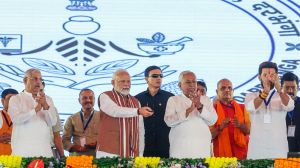As Delhi reels under water shortage for 5th consecutive day, residents say, ‘can’t dig for our own water, can we?’
The DJB’s water production report for Sunday showed Chandrawal WTP was functioning below its capacity and producing around 62.97 MGD of water.
 The Poor Families who were residing in low lying areas alongside Yamuna River leaving their homes and moving to urban cities at Mayur Vihar Station in New Delhi . Monday , 17 july , 2023. Express Photo by Ritvik Gugnani.
The Poor Families who were residing in low lying areas alongside Yamuna River leaving their homes and moving to urban cities at Mayur Vihar Station in New Delhi . Monday , 17 july , 2023. Express Photo by Ritvik Gugnani. Parts of the city continue to reel under water shortage with the Wazirabad water treatment plant (WTP) not functioning at full capacity yet and tubewells along the floodplains remaining submerged.
Monday was the fifth day that water supply in the city has been disrupted, after three WTPs — Wazirabad, Chandrawal and Okhla — were shut on July 13 on account of rising water levels in the Yamuna that submerged the equipment at these plants.
While supply has resumed in some areas after the Okhla WTP began operating Friday, Chandrawal on Sunday, and Wazirabad WTP working partially on Monday, parts of the city continue to receive little to no supply.
Delhi Jal Board (DJB) vice-chairman Somnath Bharti said Wazirabad WTP is producing around 101 MGD (million gallons per day) of water, and work is on to restore the plant to its full capacity.
“We are hopeful that by tonight, we will be able to run additional motors and production will be at optimum level at Wazirabad, bridging the deficit of around 33 MGD at the plant,” Bharti said.
He added the Chandrawal WTP was producing around 105 MGD on Monday, and the Okhla WTP was functioning at its full capacity of 22 MGD.
The DJB’s water production report for Sunday showed Chandrawal WTP was functioning below its capacity and producing around 62.97 MGD of water.
The city is now short of around 65 MGD of water — 33 MGD from Wazirabad and 32 MGD from the tubewells. This is in addition to the existing demand that the DJB is already unable to meet. The DJB normally produces around 990 MGD of water, against an estimated demand of around 1,380 MGD.
The Jal Board is still unable to draw groundwater from tubewells located on the floodplain. “Groundwater supply from Palla will take time (to resume) since it’s in the floodplain area. That supply is directed mostly towards Narela,” Bharti said.
On why several areas continue to report shortages, Bharti said, “Once you start supplying after a gap of three-four days, the tail-end areas will take a day or two more. Front-end areas will consume all the water that is being supplied. Once their demand is fulfilled, then water flows further.”
Complaints pour in
Parts of North and Central Delhi that rely on WTPs at Wazirabad and Chandrawal have been particularly hard hit. Nirbhay Narula, general secretary, Model Town RWA, said, “There has been a shortage for five days now. Supply resumed this morning, but the water that is coming is dirty and smelly. Yesterday, supply was partially restored.” Model Town receives 100% of its supply from Chandrawal and Wazirabad WTPs.
In Narela, which receives all its supply from ranney wells and tubewells, Vijay Passi, president of Indra Colony RWA, said supply has been disrupted for nearly a week. “There’s no water in the entire area, and we have not seen tankers either. We are using submersible pumps,” he said.
In parts of the Walled City, supply is yet to resume. Mohammad Nasir, president of an RWA in Ballimaran, said, “The area is slightly elevated compared to surrounding areas like Civil Lines, and there is a perpetual shortage. There was no water this morning, it has not come in the evening as well. It has been nearly six days since we got water. In this area, with narrow lanes, they say it is difficult for them to supply via tankers. People buy cans of water or use a submersible pump if they have one. These are not unauthorised colonies. These are densely populated areas. But we are helpless. We cannot dig for our own water, can we?”
A DJB official in the Old Delhi area said supply had resumed in some parts Sunday, but those areas receiving water from Wazirabad still face a shortage.
When the DJB had issued a note warning of water shortage across the city on July 13, it had said the contingency plan was to provide a certain number of tankers in each assembly constituency that was affected. Model Town, for instance, was to receive 10 tankers, while 15 tankers were to be deployed in Sadar Bazar.







